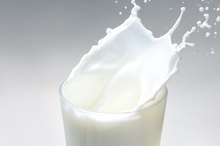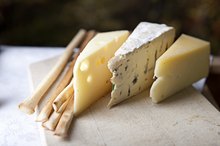What does fact checked mean?
At Healthfully, we strive to deliver objective content that is accurate and up-to-date. Our team periodically reviews articles in order to ensure content quality. The sources cited below consist of evidence from peer-reviewed journals, prominent medical organizations, academic associations, and government data.
- Mayo Clinic; What's the Difference Between a Food Intolerance and Food Allergy?; James T. C. Li, M.D
The information contained on this site is for informational purposes only, and should not be used as a substitute for the advice of a professional health care provider. Please check with the appropriate physician regarding health questions and concerns. Although we strive to deliver accurate and up-to-date information, no guarantee to that effect is made.
Can I Be Allergic to Cottage Cheese?
Cottage cheese results from a reaction between the proteins in milk and the enzyme rennin. In a milk-rennin mixture, most proteins form solid clumps called curds. The rest of them remain in a liquid state called whey. Cottage cheese manufacturers typically press much of the whey out of their product to improve its density and flavor. Cottage cheese, as a milk-based food, may be highly allergenic for some people.
Cottage Cheese Proteins
The curds in cottage cheese consist of proteins called casein. Casein accounts for 80 percent of milk protein, notes Karen Smith, Ph.D., of Wisconsin's Center for Dairy Research. Easily digestible caseins are a ready source of amino acids. Some people, however, don't fully digest the whey proteins beta-lactoglobulin and alpha-lactalbumin. The undigested beta-lactoglobulin may be the protein responsible for most milk allergies.
- The curds in cottage cheese consist of proteins called casein.
- Some people, however, don't fully digest the whey proteins beta-lactoglobulin and alpha-lactalbumin.
Allergy Mechanism
Casein and Lactose
Learn More
If you suffer from a milk protein allergy, your immune system responds to cottage cheese proteins as if they were hostile invading organisms. When the proteins enter your bloodstream, your immune system produces IgE antibodies. These antibodies signal your mast cells to release several chemical, including histamines, to fight the proteins. Histamines are responsible for your allergy symptoms.
- If you suffer from a milk protein allergy, your immune system responds to cottage cheese proteins as if they were hostile invading organisms.
- When the proteins enter your bloodstream, your immune system produces IgE antibodies.
Symptoms
Symptoms of a cottage cheese allergy surface between minutes and a few hours. Typical reactions typically include:
- hives or eczema
- diarrhea
- nausea or other digestive problems
- respiratory distress including watering eyes
- sneezing
- wheezing or asthma
The reaction usually subsides within 24 hours. In some cases, however, cottage cheese ingestion can lead to anaphylaxis. This life-threatening condition requires immediate medical attention. Sings of anaphylaxis include mouth, throat and airway swelling, dizziness or fainting and shock.
- Symptoms of a cottage cheese allergy surface between minutes and a few hours.
- In some cases, however, cottage cheese ingestion can lead to anaphylaxis.
Lactose Intolerance
What Are Foods to Avoid With a Dairy Allergy?
Learn More
People sensitive to the lactose sugar in cottage cheese may mistake their symptoms for an allergic reaction. Lactose intolerance causes digestive discomfort and bloating. The condition doesn't cause an immune system response. It results from insufficient production of a lactose-digesting enzyme. Some lactose-intolerant people can eat small amounts of cottage cheese without a problem. Medical tests can determine whether a reaction to cottage cheese is allergy- or intolerance-related 3.
- People sensitive to the lactose sugar in cottage cheese may mistake their symptoms for an allergic reaction.
- Some lactose-intolerant people can eat small amounts of cottage cheese without a problem.
Treatment
A diagnosis of milk allergy means you'll have to avoid cottage cheese and all products containing dairy proteins. These proteins show up in a range of processed food, from milk chocolate and breakfast cereals to processed meats. Food manufacturers are legally required to list milk or milk ingredients on their labels. Finding alternative sources for the calcium, Vitamin D and high-quality protein that milk provides may take some effort. Foods with soy, and many vegetables -- including broccoli and spinach -- are healthy milk replacements, according to the Cleveland Clinic website.
- A diagnosis of milk allergy means you'll have to avoid cottage cheese and all products containing dairy proteins.
Related Articles
References
- Indiana Public Media Moment of Science; Miss Muffet and Her Curds and Whey; Don Glass; September 2003
- KidsHealth; TeensHealth from Nemours; Milk Allergy
- Mayo Clinic; What's the Difference Between a Food Intolerance and Food Allergy?; James T. C. Li, M.D
- Cheese, cottage, low-fat, 2% milk fat. U.S. Department of Agriculture. Published April 15, 2019.
- Lordan R, Tsoupras A, Mitra B, Zabetakis I. Dairy Fats and Cardiovascular Disease: Do We Really Need to be Concerned?. Foods. 2018;7(3). doi:10.3390/foods7030029
- Thorning TK, Raben A, Tholstrup T, Soedamah-muthu SS, Givens I, Astrup A. Milk and dairy products: good or bad for human health? An assessment of the totality of scientific evidence. Food Nutr Res. 2016;60:32527. doi:10.3402/fnr.v60.32527
- Rozenberg S, Body JJ, Bruyère O, et al. Effects of Dairy Products Consumption on Health: Benefits and Beliefs--A Commentary from the Belgian Bone Club and the European Society for Clinical and Economic Aspects of Osteoporosis, Osteoarthritis and Musculoskeletal Diseases. Calcif Tissue Int. 2016;98(1):1-17. doi:10.1007/s00223-015-0062-x
- Kliem KE, Givens DI. Dairy products in the food chain: their impact on health. Annu Rev Food Sci Technol. 2011;2:21-36. doi:10.1146/annurev-food-022510-133734
Writer Bio
Passionate for travel and the well-written word, Judy Wolfe is a professional writer with a Bachelor of Arts in English literature from Cal Poly Pomona and a certificate in advanced floral design. Her thousands of published articles cover topics from travel and gardening to pet care and technology.









